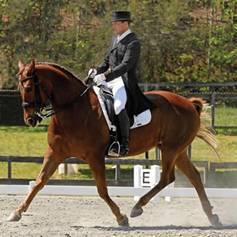In part one of this two-part series, Christine Armishaw discussed the difference between impulsion and speed . In part two she looks at what you can do to improve impulsion.

Create More Energy with Adjustability in the Gait
To create more activity and engagement, transitions are tops, specifically transitions within the pace. A great flatwork exercise to develop impulsion is shortening and lengthening the trot, using your body and your rising.
Between horse and rider, there is always a leader and a follower. In a rising trot, you can be the leader by setting the pace, rhythm, and tempo with your posting, rather than simply rising to your horse’s standard trot.
To shorten the trot stride, make only small rises off your seat. To lengthen, make your rising bigger, by increasing the time you spend in the air out of the saddle. Sometimes it helps to count one, two, one, two ¦ out loud, as you rise and sit, to maintain the desired trot tempo.
Count your steps and alternate between shortening and lengthening every 20 strides. Decrease this number and make the transitions more frequent as your horse begins to understand and make progress. If your horse breaks into walk or canter, simply ask for a trot again and resume the process. It can be beneficial to have someone on the ground, watching your horse’s legs to spot the increase in airtime, the trademark of improved impulsion. Keep your sessions short and sweet, be patient and praise your horse for getting it right.

This kind of impulsion development should be included in every ride, to enhance your horse’s way of going and, with consistent time and effort, hopefully your dressage scores too.



